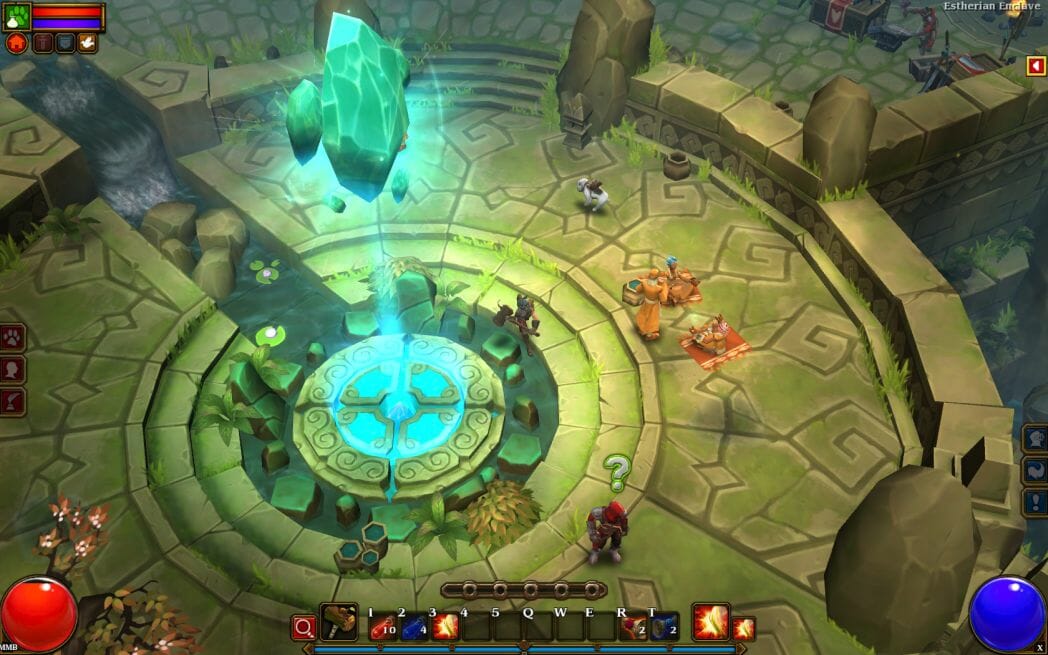
I was amazed at how Torchlight felt the first time I played it. Kill an enemy with a critical hit and the entire screen seemed to shake with glee over the deed. Eventually the game grew a bit too generic, however. The challenge petered out, I grew weary of the skill tree, and the story never grabbed me.
The story of Torchlight II still doesn’t manage to grab me, given how closely it follows the plot of Diablo 2. A hero of the last game has been corrupted and you now track him to make sure he doesn’t destroy the world. Look, there’s generic medieval fantasy forest followed by a desert followed by a marsh (instead of a jungle). It just feels a little on the nose in this department, but speaks to what the game is meant to do: give us a fresh, new Diablo 2.
It improves on that formula with options: select one of four classes and either male or female before making even more cosmetic changes that include skin color. Upon starting to level up, three unique skill trees await your perusal. Instead of one common tree that gives everyone the same type of passive abilities, each tree in the sequel provides passives tied to whatever the tree does. My embermage has a shield that, whenever he is struck, ensures that enemies have a chance to be teleported away in a random direction.
Which means the drip-feed of clicking monsters for loot and nuggets for XP feels stronger in Torchlight II. Despite how akin to Diablo 2 (and therefore, Diablo 3) the game is in its story and act structure, the change of pace and environments helps make it like a larger and grander experience than crawling around in a dungeon and returning to the same town over and over. Maps are larger with many separate dungeons to explore, providing a number of quests and varying enemies in pockets.
In fact the environments are full of small little details that are amusing enough to just sit and observe, from dungeons that have statues that reminded me very clearly of those eye-beam shooting trials of Neverending Story, to fully equipped labs that housed plenty of enemies whose corpses disappeared once I finished them. Those corpses disappear with rather glorious death animations at times, with large booms and spectacular sounds.

There is plenty of death in Torchlight II. This is a game that believes in a little challenge early on (I started on normal, though could have easily jumped into a higher difficulty), seeing as I saw my life bar jump quite rapidly at certain points when finding myself surrounded by enemies. As a squishy embermage, this made me glad to have options: the option to teleport, to use a variety of tactics and spells, and to quaff potion after potion.
This time around, potions are relegated to a consumables tab, so that I often forgot just how many I had unless I tacked them on to my skill bar. Inventory management still beams like a charm, with your friendly pet at your side to take a large portion and return to town to sell off items. This time around, your pet can even carry a small shopping list in case you need more potions or more identify or waypoint scrolls. In fact, going back to town often became a matter of whether I had a quest to turn in, rather than dealing with my inventory.
There are minor things that made me stop and think, though. I couldn’t figure out why some items needed to be identified, and not others. The determination seems completely random, as most items come already identified, and you may have an item that isn’t particularly powerful or significant require that scroll of identification. It seems an odd design choice tied to tradition, rather than following the rest of the game’s footsteps of improving and iterating on other aspects of the genre.
However, due to the small amount of identification that actually went on in the larger scheme of things, it meant that the game kept flowing forward in a mesmerizing fashion. Without needing to constantly visit the town (and often being confused when I did), I just kept marching on, wondering when that tank-like pet would return to distract some of my enemies so I could line up the perfect spells to make them lurch through their various death throes. Action RPGs are known for the click, and clicking happened in long strings.
Torchlight II is an improvement: over the first game, on the genre, and perhaps on our expectations. A few puzzles and other challenges freshen up the expected clicking, but Torchlight II is a bit too much of the same in that it relegates story to a confusing, rehashed mess that lacks any of the originality of the system’s design. I don’t regret my time with Torchlight II, but I’ll keep waiting for the genre to move forward as a whole, rather than just in small, iterative steps.
Torchlight II was developed and published by Runic Games. It is available for the PC.
Denis Farr is a writer who enjoys flitting about and providing words for those who may desire them. Please feel free to exchange lovely words with him via Twitter.